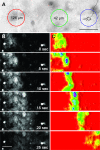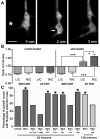Astrocytic Ca(2+) waves guide CNS growth cones to remote regions of neuronal activity
- PMID: 19002247
- PMCID: PMC2577300
- DOI: 10.1371/journal.pone.0003692
Astrocytic Ca(2+) waves guide CNS growth cones to remote regions of neuronal activity
Abstract
Activity plays a critical role in network formation during developmental, experience-dependent, and injury related remodeling. Here we report a mechanism by which axon trajectory can be altered in response to remote neuronal activity. Using photoconductive stimulation to trigger high frequency action potentials in rat hippocampal neurons in vitro, we find that activity functions as an attractive cue for growth cones in the local environment. The underlying guidance mechanism involves astrocyte Ca(2+) waves, as the connexin-43 antagonist carbenoxolone abolishes the attraction when activity is initiated at a distance greater than 120 microm. The asymmetric growth cone filopodia extension that precedes turning can be blocked with CNQX (10 microM), but not with the ATP and adenosine receptor antagonists suramin (100 microM) and alloxazine (4 microM), suggesting non-NMDA glutamate receptors on the growth cone mediate the interaction with astrocytes. These results define a potential long-range signalling pathway for activity-dependent axon guidance in which growth cones turn towards directional, temporally coordinated astrocyte Ca(2+) waves that are triggered by neuronal activity. To assess the viability of the guidance effect in an injury paradigm, we performed the assay in the presence of conditioned media from lipopolysaccharide (LPS) activated purified microglial cultures, as well as directly activating the glia present in our co-cultures. Growth cone attraction was not inhibited under these conditions, suggesting this mechanism could be used to guide regeneration following axonal injury.
Conflict of interest statement
Figures




Similar articles
-
Attractive axon guidance involves asymmetric membrane transport and exocytosis in the growth cone.Nat Neurosci. 2007 Jan;10(1):58-66. doi: 10.1038/nn1814. Epub 2006 Dec 10. Nat Neurosci. 2007. PMID: 17159991
-
STIM1 Is Required for Remodeling of the Endoplasmic Reticulum and Microtubule Cytoskeleton in Steering Growth Cones.J Neurosci. 2019 Jun 26;39(26):5095-5114. doi: 10.1523/JNEUROSCI.2496-18.2019. Epub 2019 Apr 25. J Neurosci. 2019. PMID: 31023836 Free PMC article.
-
Functional NMDA receptors at axonal growth cones of young hippocampal neurons.J Neurosci. 2011 Jun 22;31(25):9289-97. doi: 10.1523/JNEUROSCI.5639-10.2011. J Neurosci. 2011. PMID: 21697378 Free PMC article.
-
Bidirectional astrocyte-neuron communication: the many roles of glutamate and ATP.Novartis Found Symp. 2006;276:208-17; discussion 217-21, 233-7, 275-81. doi: 10.1002/9780470032244.ch16. Novartis Found Symp. 2006. PMID: 16805432 Review.
-
Second messengers and membrane trafficking direct and organize growth cone steering.Nat Rev Neurosci. 2011 Apr;12(4):191-203. doi: 10.1038/nrn2996. Epub 2011 Mar 9. Nat Rev Neurosci. 2011. PMID: 21386859 Free PMC article. Review.
Cited by
-
Effects of cordycepin on the microglia-overactivation-induced impairments of growth and development of hippocampal cultured neurons.PLoS One. 2015 May 1;10(5):e0125902. doi: 10.1371/journal.pone.0125902. eCollection 2015. PLoS One. 2015. PMID: 25932642 Free PMC article.
-
Intercellular Ca(2+) waves: mechanisms and function.Physiol Rev. 2012 Jul;92(3):1359-92. doi: 10.1152/physrev.00029.2011. Physiol Rev. 2012. PMID: 22811430 Free PMC article. Review.
-
Detection of Memory Engrams in Mammalian Neuronal Circuits.eNeuro. 2024 Aug 7;11(8):ENEURO.0450-23.2024. doi: 10.1523/ENEURO.0450-23.2024. Print 2024 Aug. eNeuro. 2024. PMID: 38997146 Free PMC article.
-
Multiscale vision model for event detection and reconstruction in two-photon imaging data.Neurophotonics. 2014 Jul;1(1):011012. doi: 10.1117/1.NPh.1.1.011012. Epub 2014 Aug 27. Neurophotonics. 2014. PMID: 26157968 Free PMC article.
-
Resveratrol Rescues the Impairments of Hippocampal Neurons Stimulated by Microglial Over-Activation In Vitro.Cell Mol Neurobiol. 2015 Oct;35(7):1003-15. doi: 10.1007/s10571-015-0195-5. Epub 2015 Apr 22. Cell Mol Neurobiol. 2015. PMID: 25898934 Free PMC article.
References
-
- De Paola V, Holtmaat A, Knott G, Song S, Wilbrecht L, et al. Cell type-specific structural plasticity of axonal branches and boutons in the adult neocortex. Neuron. 2006;49:861–875. - PubMed
-
- Gogolla N, Galimberti I, Caroni P. Structural plasticity of axon terminals in the adult. Curr Opin Neuro. 2007;17:516–524. - PubMed
-
- Chen R, Cohen LG, Hallett M. Nervous system reorganization following injury. Neuroscience. 2002;111(4):761–773. - PubMed
-
- Neumann H. Molecular mechanisms of axonal damage in inflammatory central nervous system diseases. Curr Opin Neurol. 2003;16(3):267–73. - PubMed
Publication types
MeSH terms
Substances
LinkOut - more resources
Full Text Sources
Miscellaneous

